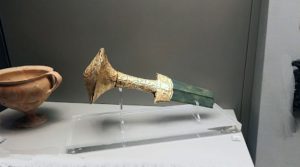The Ancient Stafylos Archaeological Site

At the northern end of Stafylos Beach, you’ll find the entrance to the ancient Stafylos archaeological site. This site is a testament to the island’s long and storied history, offering a glimpse into the past that spans several centuries.
As you explore the site, you’ll come across Mycenaean tombs dating back to the 16th century BC. These burial sites offer valuable insights into the lives and customs of the island’s early inhabitants. The artifacts discovered here include pottery, jewelry, and weapons, shedding light on the island’s role in ancient trade networks.
Beyond the tombs, you’ll find the remains of an ancient city. While much of it is now covered by vegetation, the outlines of buildings and streets are still visible. Archaeologists have uncovered pottery, coins, and other artifacts that provide clues about the daily life of the island’s residents during different historical periods.
One of the most remarkable features of the site is the ancient theater, which could accommodate around 2,000 spectators. Imagine sitting in the same spot where ancient Greeks once gathered to watch performances, and you’ll feel a deep connection to the island’s cultural heritage.
